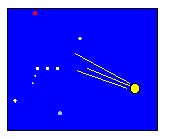 |
Astronomy 101 Problem Set #9 Solutions |  |
 |
Astronomy 101 Problem Set #9 Solutions |  |
Problem #1: Jupiter's moon Metis has a radius of only 20 km, and a mass of 9 x 1016 kg.
a) Calculate this moon's average density.
b) Based on your result above, would you say that Metis is made primarily of rock or ice? Justify your answer.
Solution: Density is mass/volume, and we're given the mass, so all we really need to do is to calculate the volume. Let's first get the radius of Metis into a better choice for units:
Comparing this result with the densities listed on the 30 September web page, I see that the density of Metis is pretty close to the density of plain old rock (and a lot higher than that of water and ice), so I conclude that Metis is a rocky moon
Note that I could've calculated the density of Metis in units of kg/km3, but then I wouldn't really be able to compare that density with the density of other things, since I don't have a list of the densities of other things in those units. This is yet another reason to always choose "standard" units.
Problem #2: Saturn is currently 9.03 A.U. away from Earth. Calculate how long it takes for a radio signal sent from Earth to be received by the Cassini spaccecraft in orbit around Saturn.
Solution: This problem is very straightforward. It's just an application of the old "speed = distance/time" relationship. We're given the distance that the radio waves have to travel, and we're asked how long it will take for them to get there. All we really need is the speed, and since RADIO WAVES ARE LIGHT WAVES (just like infrared light, ultraviolet light, x-ray light, and of course, visible light), they travel at the SPEED OF LIGHT, 3.0 x 108 m/s.
Let's start by getting the distance into units that are commensurate with the speed quoted above. Here, we'll need units of meters, so.
Problem #3: a) Calculate the radius of the Roche limit for the Earth.
b) The Space Shuttle orbits the Earth at an altitude of approximately 150 km. Does it orbit inside the Earth's Roche limit? If so, why isn't it ripped apart?
Solution: The first part is pretty straightforward. Just take the radius of the Earth and multiply by 2.44 (this value is from your textbook; I used 2.5 in class, and frankly, either value is just fine for the approximations we're making here):
Now, what about the Space Shuttle? Since it orbits 150 km above the Earth's surface, the radius of its orbit is 150 + 6378 km, or 6500 km, so the Space Shuttle orbits well inside the Earth's Roche limit. So why doesn't it get ripped apart? The answer comes from the definition of the Roche limit. Within the Roche limit, the tidal stretching due to the Earth's gravity is greater than the gravitational attraction two objects feel for one another. As a result, objects held together by self-gravity will get ripped apart. However, if an object is held together by something other than self-gravity, such as bolts and rivets, or chemical bonds, it won't get ripped apart. Thus the Space Shuttle, which is held together by a lot more than just its self-gravity, doesn't get ripped to shreds.
Do not be confused into thinking that the Roche limit defines some danger zone inside of which everything is ripped to shreds. Instead, it's simply defined as the zone in which tidal stretching can overcome self-gravity. This is important for dust particles like those in Saturn's rings, because it means that these particles will not get pulled together by their own gravitational attraction for one another. Instead, the tidal effects from nearby Saturn spreads these particles out into the broad, flat ring structure we see.
